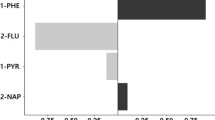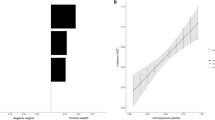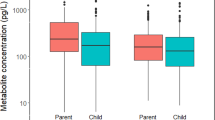Abstract
The aim of this study was to evaluate the usefulness and specificity of urinary 1-hydroxypyrene (1-OHPu) as a biomarker of the exposure from urban pollution to polycyclic aromatic hydrocarbons (PAHs) among outdoor workers in a meta-analysis. Our meta-analysis was performed according to standard methods, and the results show that the concentrations of 1-OHPu tend to be higher in exposed workers than in unexposed workers (if we exclude two highly heterogeneous articles), in exposed non-smokers than in unexposed non-smokers and in exposed than in unexposed workers who were carriers of the CYP1A1 genotype and in those with the glutathione-S-transferase M1 (−)genotype. These genotypes enhance the effect of exposure, particularly in non-smokers. Smoking reduces the differences between exposed and unexposed subjects. In conclusion, our results suggest that the use of the 1-OHPu biomarker appears to be reliable for studying occupational exposure to PAHs from urban pollution, as long as environmental and behavioural factors are considered.
This is a preview of subscription content, access via your institution
Access options
Subscribe to this journal
Receive 6 print issues and online access
$259.00 per year
only $43.17 per issue
Buy this article
- Purchase on Springer Link
- Instant access to full article PDF
Prices may be subject to local taxes which are calculated during checkout




Similar content being viewed by others
Abbreviations
- CYP:
-
cytochrome P450
- GST:
-
glutathione S-transferase
- 1-OHPu:
-
urinary 1-hydroxypyrene
- PAHs:
-
polycyclic aromatic hydrocarbons
- PYRH:
-
hydrocarbon pyrene
References
IARC Some non-heterocyclic polycyclic aromatic hydrocarbons and some related industrial exposures. Volume 92 in preparation. Meeting Report. Air Pollution, Part 1. 2008. available at: http://monographs.iarc.fr/ENG/Meetings/92-pahs.pdf.
Orjuela MA, Liu X, Warburton D, Siebert AL, Cujar C, Tang D et al Prenatal PAH exposure is associated with chromosome-specific aberrations in cord blood. Mutat Res 2010; 703: 108–114.
Sancini A, Caciari T, Andreozzi G, Scimitto L, Schifano MP, Di Giorgio V et al Respiratory parameters in traffic policemen exposed to urban pollution. Eur J Inflamm 2010; 8: 157–163.
Lee MS, Magari S, Christiani DC . Cardiac autonomic dysfunction from occupational exposure to polycyclic aromatic hydrocarbons. Occup Environ Med 2010; 68: 474–478.
Wu J, Hou H, Ritz B, Chen Y . Exposure to polycyclic aromatic hydrocarbons and missed abortion in early pregnancy in a Chinese population. Sci Total Environ 2010; 408: 2312–2318.
Han X, Zhou N, Cui Z, Ma M, Li L, Cai M et al Association between urinary polycyclic aromatic hydrocarbon metabolites and sperm dna damage: A population study in Chongqing, China. Environ Health Perspect 2010; 119: 652–657.
Allan LL, Sherr DH . Disruption of human plasma cell differentiation by an environmental polycyclic aromatic hydrocarbon: a mechanistic immunotoxicological study. Environ Health 2010; 9: 15.
Tang Y, Donnelly KC, Tiffany-Castiglioni E, Mumtaz MM . Neurotoxicity of polycyclic aromatic hydrocarbons and simple chemical mixtures. J Toxicol Environ Health A 2003; 66: 919–940.
Apostoli P, Cassano F, Clonfero E, Dell’Omo M, Fiorentino ML, Izzotti A et al The toxicology and prevention of the risks of occupational exposure to aromatic polycyclic hydrocarbons. II. Toxicology. Exposure assessment. Environmental and biological monitoring. G Ital Med Lav Ergon 1997; 19: 137–151.
Bacaloni A, Cafaro C, De Giorgi L, Ruocco R, Zoccolillo L . Improved analysis of polycyclic aromatic hydrocarbons in atmospheric particulate matter by HPLC-fluorescence. Ann Chim 2004; 94: 751–759.
Bocca B, Crebelli R, Menichini E (eds). Presenza degli idrocarburi policiclici aromatici negli alimenti. Istituto Superiore di Sanità: Roma. 2003 Rapporti ISTISAN 03/22.
Neri G . Influence of genetic polymorphism of CYP1A1 and GSTM1 on the levels of urinary 1-hydroxypyrene. G Ital Med Lav Ergon 2003; 25: 466–470.
Pastorelli R, Cerri A, Rozio M, Dell’Omo M, Muzi G, Abbritti G et al Benzo (a)pyrene diolepoxide adducts to albumin in workers exposed to polycyclic aromatic hydrocarbons: association with specific CYP1A1, GSTM1, GSTP1 and EHPX polymorphic genotypes. Biomarkers 2001; 6: 357–374.
Fagundes RB, Abnet CC, Strickland PT, Kamangar F, Roth MJ, Taylor PR et al Higher urine 1-hydroxy pyrene glucuronide (1-OHPG) is associated with tobacco smoke exposure and drinking maté in healthy subjects from Rio Grande do Sul, Brazil. BMC Cancer 2006; 26: 139.
Roggi C, Maccarini L, Bernabeo F, Sciarra G, Aprea C, Cenni A et al Valori di riferimento dell’ldrossipirene urinario in tre regioni italiane. In: Aprea C, Sciarra G, Fiorentino ML, Minoia C (Ed.ri) I Valori di Riferimento e i Valori Limite nella Prevenzione Ambientale e Occupazionale- Morgan Edizioni Tecniche-Milano. 1996 pp 67–88.
Sciarra G . Environmental and biological reference values of aromatic polycyclic hydrocarbons. G Ital Med Lav Ergon 2003; 25: 83–93.
Jongeneelen FJ, Anzion RBM, Scheepers PTJ, Bos RP, Henderson PTH, Nijenhuis EH et al 1-Hydroxypyrene in urine as a biological indicator of exposure to polycyclic aromatic hydrocarbons in several work environments. Ann Occup Hyg 1988; 32: 35–43.
Jongeneelen FJ . Benchmark guideline for urinary 1-hydroxypyrene as biomarker of occupational exposure to polycyclic aromatic hydrocarbons. Occup Hyg 2001; 45: 3–13.
Sancini A, Fioravanti M, Ciarrocca M, Palermo P, Fiaschetti M, Schifano MP et al Pulmonary nodules in workers exposed to urban stressor. Environ Res 2010; 110: 519–525.
Abbritti G . Biological monitoring of the exposure to polycyclic aromatic hydrocarbons. Final report 3° year. University of Perugia, Department of Clinical and Experimental Medicine, Section of Occupational Medicine and Toxicology and Environmental Professional. Research funded by ISPESL 2006.
Jongeneelen FJ, Anzion RBM, Henderson PT . Determination of hydroxylated metabolites of polycyclic aromatic hydrocarbons in urine. J Chromatogr 1987; 413: 227–232.
Apostoli P, Porru S . Biological monitoring and risk assessment. In:. Advances in Occupational Medicine vol. 1. Maugeri Foundation Books: Pavia. 2000. pp 227–233.
Apostoli P . The reference value. In:. Advances in Occupational Medicine vol. 1. Maugeri Foundation Books: Pavia. 2000 pp 245–260.
Balbiani L . Assorbimento transcutaneo dei tossici industriali. G Ital Med Lav Erg 2003. available at: www.gimle.fsm.it.
Buchet JP, Gennart JP, Mercado-Calderon F, Delavignette JP, Cupers L, Lauwerys R . Evaluation of exposure to PAH in a coke production and graphite electrode manufacturing plant. Br J Ind Med 1992; 49: 761–768.
Jongeneelen FJ, van Leeuwen FE, Oosterink S, Anzion RB, Van der Loop F, Bos RP et al Ambient and biological monitoring of cokeoven workers; determinants of the internal dose of PAH. Br J Ind Med 1990; 47: 454–461.
Keimig SD, Kirby KW, Morgan DP, Keiser JE, Hubert TD . Identification of 1-hydroxypyrene as a major metabolite of pyrene in pig urine. Xenobiotica 1983; 13: 415–420.
Jacob J, Bruneb H, Gettbarna G, Grimmera D, Heinrichc U, Mohtashamipur E et al Urinary and faecal excretion of pyrene and hydroxypyrene by rats after oral, intraperitoneal, intratracheal or intrapulmonary application. Cancer Lett 1989; 46: 15–20.
Rubino FM, Verduci C, Buratti M, Fustinoni S, Neri L, Brambilla G et al Biomonitoring of exposure to PAH: the pyrene vs. 1-hydroxypyrene paradox. G Ital Med Lav Ergon 2004; 26 (Suppl): 4.
Bouchard M, Krishnan K, Viau C . Urinary excretion kinetics of 1-hydroxypyrene following intravenous administration of binary and ternary mixtures of polycyclic aromatic hydrocarbons in rat. Arch Toxicol 1998; 72: 475–482.
Jongeneelen FJ . Biological exposure limit for occupational exposure to coal tar pitch volatiles at cokeovens. Int Arch Occup Environ Health 1992; 63: 511–516.
Wang L, Cohly H, Yan J, Graham-Evans B, Hwang HM, Yu H . UVA light-induced toxic effects of 1-hydroxypyrene on human jurkat T-cells. Bull Environ Contam Toxicol 2004; 72: 1240–1246.
Ekunwe SI, Hunter RD, Hwang HM . Ultraviolet radiation increases the toxicity of pyrene, 1-aminopyrene and 1-hydroxypyrene to human keratinocytes. Int J Environ Res Public Health 2005; 2: 58–62.
Crofts F, Taioli E, Trachman J, Cosma GN, Currie D, Toniolo P et al Functional significance of different human CYP1A1 genotypes. Carcinogenesis 1994; 15: 2961–2963.
Nebert DW, Petersen DD, Puga A . Human AH locus polymorphism and cancer: inducibility of CYP1A1 and other genes by combustion product and dioxin. Pharmacogenetics 1991; 1: 68–78.
Xu X, Kelsy KT, Wiencke JK, Wain JC, Christiani DC . Cytochrome P450 CYP1A1 MspI polymorphism and lung cancer susceptibility. Cancer Epidemiol Biol Prev 1996; 5: 687–692.
Buckley TJ, Lioy PJ . An examination of the time course from human dietary exposure to polycyclic aromatic hydrocarbons to urinary elimination of 1-hydroxypyrene. Br J Ind Med 1992; 49: 113–124.
Phillips DH . Polycyclic aromatic hydrocarbons in the diet. Mutat Res 1999; 443: 139–147.
Kawamoto T, Yang M, Kim YD, Kim H, Oyama T, Isse T et al Effects of lifestyle on urinary 1-hydroxypyrene concentration. J Occup Health 2007; 49: 183–189.
Kim YD, Todoroki H, Oyama T, Isse T, Matsumoto A, Yamaguchi T et al Identification of cytochrome P450 isoforms involved in 1-hydroxylation of pyrene. Environ Res 2004; 94: 262–266.
Higgins J, Green SE . Cochrane Handbook for Systematic Reviews of Interventions, Version 5.0.1. The Cochrane Collaboration: London. 2008.
*Perico A, Gottardi M, Boddi V, Bavazzano P, Lanciotti E . Assessment of exposure to polycyclic aromatic hydrocarbons in police in Florence, Italy, through personal air sampling and biological monitoring of the urinary metabolite 1-hydroxypyrene. Arch Environ Health 2001; 56: 506–512.
*Kuusimäki L, Peltonen Y, Mutanen P, Peltonen K, Savela K . Urinary hydroxy-metabolites of naphthalene, phenanthrene and pyrene as markers of exposure to diesel exhaust. Int Arch Occup Environ Health 2004; 77: 23–30.
*Adonis M, Martíneza V, Riquelme R, Ancicb P, Gonzáleza G, Tapia R et al Susceptibility and exposure biomarkers in people exposed to PAHs from diesel exhaust. Toxicol Lett 2003; 144: 3–15.
*Chuang CY, Lee CC, Chang YK, Sung FC . Oxidative DNA damage estimated by urinary 8-hydroxydeoxyguanosine: influence of taxi driving, smoking and areca chewing. Chemosphere 2003; 52: 1163–1171.
*Chuang CY, Chang CC . Urinary 1-hydroxypyrene level relative to vehicle exhaust exposure mediated by metabolic enzyme polymorphisms. J Occup Health 2007; 49: 140–151.
*Merlo F, Andreassen A, Weston A, Pan CF, Haugen A, Valerio F et al Urinary excretion of 1-hydroxypyrene as a marker for exposure to urban air levels of polycyclic aromatic hydrocarbons. Cancer Epidemiol Biomarkers Prev 1998; 7: 147–155.
*Burgaz S, Demircigil GC, Karahalil B, Karakaya AE . Chromosomal damage in peripheral blood lymphocytes of traffic policemen and taxi drivers exposed to urban air pollution. Chemosphere 2002; 47: 57–64.
*Hara K, Hanaoka T, Yamano Y, Itani T . Urinary 1-hydroxypyrene levels of garbage collectors with low-level exposure to polycyclic aromatic hydrocarbons. Sci Total Environ 1997; 199: 159–164.
*Chetiyanukornkul T, Toriba A, Kameda T, Tang N, Hayakawa K . Simultaneous determination of urinary hydroxylated metabolites of naphthalene, fluorene, phenanthrene, fluoranthene and pyrene as multiple biomarkers of exposure to polycyclic aromatic hydrocarbons. Anal Bioanal Chem 2006; 386: 712–718.
*Zhao ZH, Wenyi Q, Dehai T . Urinary 1-hydroxypyrene level as a biomarker: human exposure to ambient polycyclic aromatic hydrocarbons in China. AMBIO 1995; 24: 226–230.
*Ruchirawa M, Mahidol C, Tangjarukij C, Pui-ock S, Jensen O, Kampeerawipakorn O et al Exposure to genotoxins present in ambient air in Bangkok, Thailand-particle associated polycyclic aromatic hydrocarbons and biomarkers. Sci Total Environ 2002; 287: 121–132.
*Autrup H, Daneshvar B, Dragsted LO, Gamborg M, Hansen M, Loft S et al Biomarkers for exposure to ambient air pollution — comparison of carcinogen–DNA adduct levels with other exposure markers and markers for oxidative stress. Environ Health Perspect 1999; 107: 233–238.
*Ayi Fanou L, Mobio TA, Creppy EE, Fayomi B, Fustoni S, Møller P et al Survey of air pollution in Cotonou, Benin — air monitoring and biomarkers. Sci Total Environ 2006; 358: 85–89.
*Tomei F, Ghittori S, Imbriani M, Pavanello S, Carere A, Marcon F et al Environmental and biological monitoring of traffic wardens from the city of Rome. Occup Med 2001; 51: 198–203.
*Buratti M, Pellegrino O, Brambilla G, Colombi A . Urinary excretion of 1-hydroxypyrene as a biomarker of exposure to polycyclic aromatic hydrocarbons from different sources. Biomarkers 2000; 5: 368–381.
*Ayi Fanou L, Avogbe PH, Fayomi B, Keith G, Hountondji C, Creppy EE et al DNA-adducts in subjects exposed to urban air pollution by benzene and polycyclic aromatic hydrocarbons (PAHs) in Cotonou, Benin. Environ Toxicol 2009; 26: 93–102.
Mazzotta M, D’Ettorre G, Cazzato RG, De Giorgio N . Urinary 1-OHP excretion of urban traffic exhausts exposed workers. G Ital Med Lav Ergon 2007; 29: 539–541.
Alexandrie AK, Warholm M, Carstensen U, Axmon A, Hagmar L, Levin JO et al CYP1A1 and GSTM1 polymorphisms affect urinary 1-hydroxypyrene levels after PAH exposure. Carcinogenesis 2000; 21: 669–676.
Pigini D, Cialdella AM, Faranda P, Tranfo G . Comparison between external and internal standard calibration in the validation of an analytical method for 1-hydroxypyrene in human urine by HPLC/MS/MS. Rapid Commun Mass Spectrom 2006; 20: 1013–1018.
Boos KS, Lintelmann J, Kettrup A . Coupled column HPLC method for the determination of 1-hydroxypyrene in urine of subjects exposed to PAH. J Chromatogr 1992; 600: 189–194.
Hansen AM, Poulsen OM, Christensen JM, Hansen SH . Determination of 1 hydroxypyrene in human urine by high performance liquid chromatography. J Anal Toxicol 1993; 17: 38–41.
Lehnert G, Schaller KH, Angerer J . Report on the status of the external quality control programs for occupational-medical toxicological analyses in biological materials in Germany. Int Arch Occup Environ Health 1999; 72: 60–64.
Sancini A, Caciari T, Di Pastena C, Sinibaldi F, Scala B, Fiaschetti M et al Meta-analysis: cardiovascular effects in workers occupationally exposed to urban pollution. Prevent Res 2011; 1: 87–100. available at: www.preventionandresearch.com.
Author information
Authors and Affiliations
Corresponding author
Ethics declarations
Competing interests
The authors declare no conflict of interest.
Rights and permissions
About this article
Cite this article
Ciarrocca, M., Rosati, M., Tomei, F. et al. Is urinary 1-hydroxypyrene a valid biomarker for exposure to air pollution in outdoor workers? A meta-analysis. J Expo Sci Environ Epidemiol 24, 17–26 (2014). https://doi.org/10.1038/jes.2012.111
Received:
Accepted:
Published:
Issue Date:
DOI: https://doi.org/10.1038/jes.2012.111
Keywords
This article is cited by
-
Non-carcinogenic and cumulative risk assessment of exposure of kitchen workers in restaurants and local residents in the vicinity of polycyclic aromatic hydrocarbons
Scientific Reports (2023)
-
Exposure to polycyclic aromatic hydrocarbon-induced oxidative stress in individuals living near restaurants: a cross-sectional study in Shiraz, Iran
Environmental Monitoring and Assessment (2022)
-
Exposure to polycyclic aromatic hydrocarbon-induced oxidative stress in Shiraz, Iran: urinary levels, health risk assessment and mediation effect of MDA on the risk of metabolic syndromes
International Archives of Occupational and Environmental Health (2022)
-
The association between the urinary biomarkers of polycyclic aromatic hydrocarbons and risk of metabolic syndromes and blood cell levels in adults in a Middle Eastern area
Journal of Environmental Health Science and Engineering (2021)
-
Elevated exposure to polycyclic aromatic hydrocarbons (PAHs) may trigger cancers in Pakistan: an environmental, occupational, and genetic perspective
Environmental Science and Pollution Research (2020)



